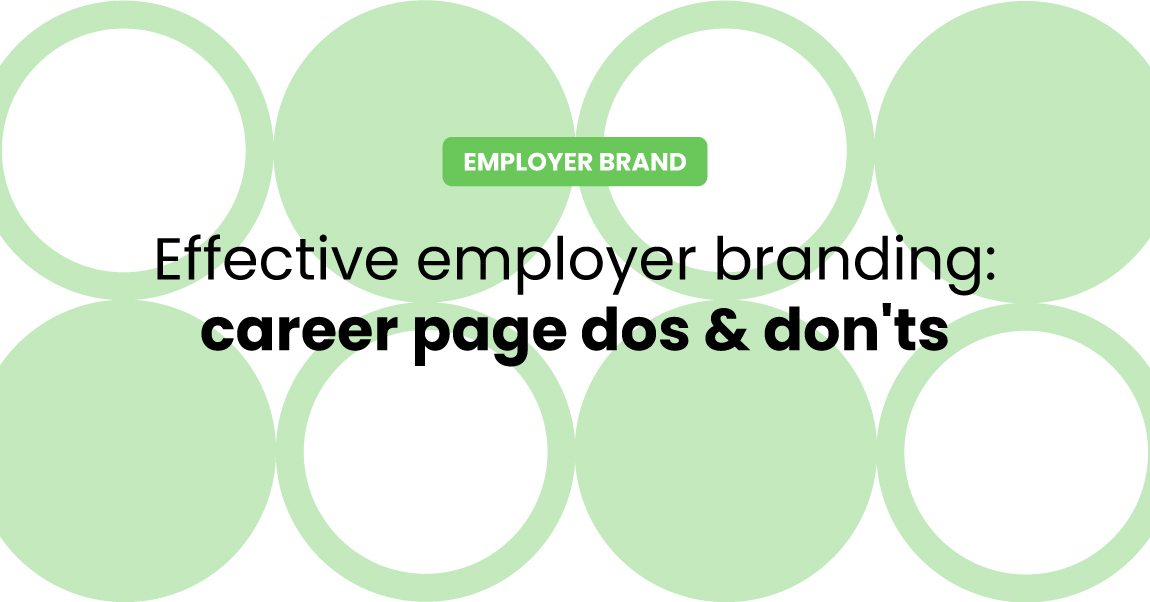A company’s website should help with meeting and greeting skilled new hires. It can emphasize the value proposition and catch the interest of the best candidates. And a well-made, strong career page is what could give an extra boost to your recruitment efforts.
However, the statistics show that many companies make similar mistakes here. In fact, studies show a staggering bounce rate. Nearly 90% of job seekers will leave these pages immediately. So it’s crucial to make a career page do’s & don’ts checklist. And follow it to dodge these common slips and ridiculous goofs. Here’s the perfectly simple guide that will help you start on the right foot! 👇
Basic definition: What is a career page?
In simple terms, a career page (careers page or careers site) is a unique corner of a company’s website that’s designed to showcase its brand and promote new jobs. It can come in the form of a single landing page or represent a microsite. Its primary aim is to attract and engage candidates. So, aside from vacancies and other employment-related topics, it should reflect the company’s culture, values, and other characteristics that make an organization stand out from others. Finally, it’s a pot of gold when it comes to organic web traffic. Active job seekers will unquestionably run their search by typing common phrases like industry + careers, and a well-optimized page will be ready to welcome them aboard.
💡 Here’s a pro tip: Make sure to track visitors to your careers pages. Knowing the precise locations, demographics, and traffic volumes data can help you boost your website and come up with a trick or two to build up your recruitment processes.
Essential ingredients: What makes a good careers page?
There are quite a few elements you could include to grab the attention of your target audience. But before you get super creative, it’s crucial to cover the basic ground first. So what should a career page include? Here’s a quick overview of the elementary ingredients:
- All the relevant information presented to candidates in multiple formats. Use written content, photos, visuals, and videos to tell your story. Start by putting yourself in a job seeker’s shoes. Which questions would you like to have answered right away?
- A chance to take a glance at the team. Speaking of photos and videos, showing who your teammates are is smart and beneficial in more ways than one. First, a potential hire will know who they’d be joining. But also, the employees are likely to feel more appreciated and recognized.
- Clear and engaging job descriptions. Aside from the roles and responsibilities presented to candidates, it’s wise to categorize jobs by department or location. Identify your precise hiring need and help potential employees understand it fully.
- User-friendly website and career pages. A candidate-focused design can make all the difference. Make the application process smooth and simple, and stick with the rules of mobile-first recruitment strategies. 90% of global talents use their phones to look for new jobs. Don’t forget it!
- A keyword-rich content that will help candidates find you. Include custom URLs and page titles, and increase your search engine rankings.
💡 Here’s an ultimate tactic to build a community and broaden your talent pool: Reach out to those who haven’t found a vacancy they’d apply for. Encourage them to send their resumes without really applying for a specific job.
5 key career page do’s and don’ts
Aside from promoting open positions, your entire website and careers pages must help you tell your story. So how to create a career page on your website & make it stand out? Here are a few noteworthy pieces of advice and some no-good practices and common mistakes to avoid at all costs. It all starts with well-written job posts.
Be careful with your job descriptions.
Filling a vacancy starts with coming up with precise requirements and writing them down. And before you share an ad with the world of talents, it’s crucial to check out whether your job description is written the way it should be. These are the elementary parts of a JD you must nail:
- A clear job title that will instantly attract qualified candidates,
- A brief introduction that contains the vital information and the company’s value proposition,
- The list of key responsibilities,
- A set of requirements with highlighted must-haves and clearly labeled nice-to-haves,
- Benefits that talents actually want to hear about and the transparent salary range.
But if you truly aim to boost hiring experience with your job posts, there are a few extra points to understand and put to practice. So you must dig a bit deeper to know exactly what your target crowd aspires to, which info is crucial to them, and what the tone should be like. So, aside from saying a few words about the project the new hire will work on, it’s always smart to emphasize why this exact position is valuable for the company. Also, it’s best to add a line or two about the future of the role. And finally, be sure to mention who the newly hired person will work with and report to. Well-crafted ads like these will make your career page more effective.
Skip the awesome, innovative, ninja-rockstar-unicorn terms.
Have you ever seen a ridiculous job post or a crazy LinkedIn title that has induced a bit too much cringe? Well, anything that involves pirates, lasers, and similar types of B.S. should be on the list of career page’s major don’ts. So, what would be a “heck of a do” here? It’s simple – always strive to write inclusive job ads. In other words, use gender-neutral language, minimize the jargon, and mention policies that clearly show your attitude toward diversity and inclusion.
Another common mistake employers make is using too many buzzwords. Not everything is cutting edge, super-compelling, and oh so awesome. First of all, many skilled candidates (especially the most experienced ones) are likely to roll their eyes far back into the days when recruiters were cold-calling them. Then, those who actually fall for the dazzling pages & cool lingo can face a massive disappointment once they start working for the new company. Those groundbreaking projects could likely turn into something far less impressive, and that leads to job dissatisfaction.
Don’t go with the flow. Make it structured.
Having confusing processes could drive applicants away. Also, it can harm your brand. So should your candidates email their resumes or connect with recruiters and hiring managers through LinkedIn? How can they get the information they seek? Set up one clear flow and stick to it. And as your network grows and your recruitment team spots new, effective sources of hire, your processes will evolve – into simplicity!
Your career page must be built on the same foundation. Keep it neat and easy to understand, and encourage job seekers to reach out. And if you use an applicant tracking system or any similar tool, the entire process of getting in touch with candidates and gathering the info will run more smoothly.
Steal your audience’s attention & win their trust.
It’s essential to learn a thing or two about the job seeker personas. Moreover, you should aim to target your audience right from the start. So, if you go for a one-size-fits-all kind of website, that won’t work like magic. So, how to deal with this segment? First, look into the site visitors. Know the demographics and learn to tell apart multiple personas who have bumped into your pages and ads. First of all, know that most of the talents are passive job seekers. Those who are actively looking for new opportunities could be interested in full-time jobs or part-time gigs. And among them, some will be seasoned professionals, while others could be recent college grads with no relevant experience. Then, start focusing on meaningful content that will genuinely aid each visitor and meet the needs of all these groups. And while a diversity statement or a basic list of benefits come as some of the fundamental parts of these pages, be sure to do a bit more and offer some extra information, encouragement, and freshness.
Know what you should dim down a notch.
It is very common to speak volumes about a company’s culture through its website and career landing pages. And sure, it has its substantial perks. A healthy environment that respects its people and recognizes their unique needs is praiseworthy. Plus, it can build a strong bond between candidate and employee experience (while enhancing both). But too much of it can be unrelentingly tiresome, uncool, or even fake. And in terms of attracting qualified applicants, if the culture is the main focus, they can easily miss the bottom line. So, if your CTA is hidden under a huge pile of awesomeness and pats on the back, you won’t have much luck with your recruitment efforts.
You should add mixed content that showcases the team and the atmosphere in your firm but keep it balanced and don’t let it cast a shadow over other parts of the page.
Always keep these career page do’s and don’ts in mind.
Make sure to check out this brief list of career page do’s and don’ts before you start setting up a tactic for posting jobs and sourcing new candidates. These tips, hacks, and best practices will guide you and help you gain the interest of the audience you actually targeted. Also, stay clear of the common slips and mistakes we’ve mentioned.
And if your hiring needs could use some extra backing, choose a trustworthy recruitment agency that will assist you and bring in the most suitable talents.




